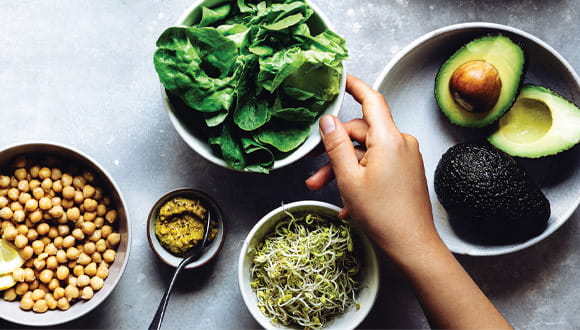Did you know that only 5% of men and 9% of women eat enough fiber on a daily basis?
The National Academy of Medicine recommends getting the following amount of fiber per day:
- Women age 50 and younger: 25 grams
- Women age 51 and older: 21 grams
- Men age 50 and younger: 38 grams
- Men age 51and older: 30 grams
"You might think of fiber as only important for GI health — relieving constipation, for instance. But getting enough fiber is so much more than that," says Amanda Beaver, wellness dietitian at Houston Methodist. "One of the main reasons to meet our fiber needs that I think people don't initially realize is how it helps benefit our cardiovascular health."
The benefits of fiber don't stop there. From fostering a diverse, happy gut microbiome and keeping you feeling full for longer, to helping lower high blood pressure, balance cholesterol levels and prevent blood sugar spikes, there are many reasons to make sure you're getting enough fiber in your diet.
Since most of us aren't, Beaver has advice for rectifying the issue.
What foods are high in fiber?
"I recommend trying to have a good source of fiber with every meal," says Beaver. "This helps ensure you're meeting your fiber needs, with the added benefit of getting the complementary nutrients, vitamins and minerals that are also present in many high fiber foods."
An important step in identifying high-fiber foods is knowing how to evaluate a nutrition label. A good source of fiber is one that contains at least 3 grams per serving. An excellent source is one that contains 6 grams per serving.
Some of the best sources of fiber are whole foods that don't always come with a nutrition label, though, so here's Beaver's cheat sheet of high-fiber foods:
- Nuts, especially almonds and pistachios, chia seeds, flax seeds, pumpkin seeds
- Beans and lentils, such as black beans, white beans, split peas, lentils, pinto beans, mung beans, chickpeas, black-eyed peas and edamame
- Whole grains, including bulgur, kamut, barley, quinoa, whole wheat pasta, oatmeal, whole wheat bread
- Veggies, like squashes, collard greens, kale, broccoli, carrots, spinach, Brussels sprouts, okra, asparagus, mushrooms
- Fruits, particularly avocado, raspberries, blackberries, persimmon, pears, oranges, apricots and apples
"I recommend trying these foods out and picking a few you find the most convenient and tasty to have at your meals and snacks," adds Beaver.
Are there high-fiber food items to avoid?
We now know what a good and excellent source of fiber looks like. But what about packaged food products that contain even higher amounts than this? Is there such a thing as too much fiber?
"Some 'Low Carb' and 'No Sugar' packaged products have 8 to 10 grams of fiber per serving — sometimes even more than this! These concentrated sources of fiber can cause GI upset, especially if eaten in large quantities," warns Beaver. "Examples that comes to mind are certain protein bars, powders and shakes, as well as low-carb bread and tortillas."
This means you'll want to look at the nutrition label. Exceedingly high amounts of fiber per serving can be hiding in foods without you even realizing it, leading to unwanted symptoms.
An irritated GI tract after consuming too much fiber can manifest as bloating, cramping, diarrhea and —contrary to what you may think — constipation.
"The 'best' fiber is the kind that comes exactly how it was packaged by nature," Beaver adds. "Usually these whole foods contain a good amount of fiber that is well-tolerated by our GI tract and offer countless other nutritional benefits — like vitamins, minerals and antioxidants — that packaged, processed high-fiber products don't always have."
How to get more fiber in your diet
There are quite a few trends for improving your fiber intake. And, sure, you can join in on popular ones, like slurping down some chia seed water.
There are also fiber supplements you could consider taking — though Beaver stresses the importance of aiming to get all the fiber you need through your diet. Fiber-rich foods come with additional benefits, like vitamins, minerals and antioxidants, that supplements can't provide.
One simple way to increase your fiber intake is to switch from refined grains to whole grains. For example, a serving of barley contains 6 grams of fiber, whereas the same amount of white rice only contains 2 grams of fiber.
"We live in a very carb-phobic world, but it's important to know that several carbohydrate sources have a good amount of fiber in them," adds Beaver. "For instance, beans, lentils and whole grains are some of the fiber superstars, and there are a lot of benefits we miss out on if we're afraid to add them to our diet."
If you need help incorporating more fiber into your day, here are a few of Beaver's simple tips that also happen to be packed with vitamins:
- Oatmeal topped with berries
- Nuts as a snack
- Chia seeds added to a smoothie
- Beans or lentils as a side
- Avocado on top of tacos or whole wheat toast
- Pre-cut broccoli or Brussels sprouts roasted in an air fryer
- Microwave quinoa as a side
- Frozen kale added to a smoothie
- Berries or apples as a side with eggs








